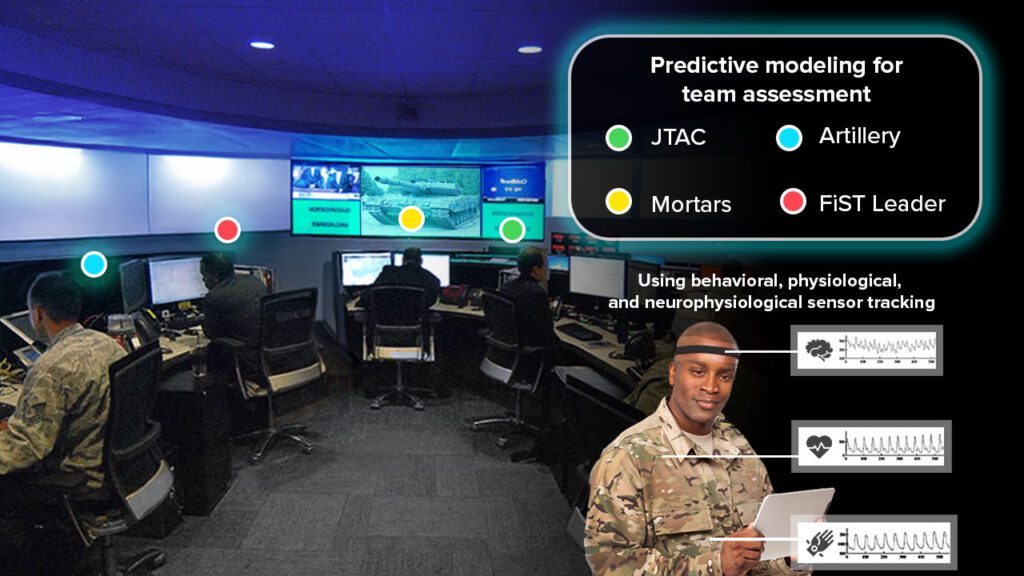BioTDMS
A real-time data feedback tool that
enhances team training effectiveness
A real-time data feedback tool that enhances team training effectiveness
Bio-Behavioral Team Dynamics Measurement System (BioTDMS)
An individual’s preparedness for a task need not always translate into productivity as a member of a team. To understand how individual readiness relates to team performance, our researchers are developing reliable, objective predictors grounded in real-time behavioral data.
BioTDMS aims to enhance team training effectiveness using real-time data for real-time feedback. BioTDMS is funded by the Defense Advanced Research Projects Agency (DARPA) under the OP TEMPO program (Objective Prediction of Team Effectiveness via Models of Performance Outcomes).

BioTDMS uses behavioral, physiological, and neurophysiological sensors to track biological and social patterns. Proposed biomarkers to be measured include electroencephalogram (EEG), which measures neural activity; functional near-infrared spectroscopy (fNIRS), which measures brain blood oxygenation as a proxy for neural activity; eye-tracking, respiration, and cardiac information; verbal communication; and others.
The BioTDMS multidisciplinary team is being led by:
Arizona State University (ASU), through the Global Security Initiative’s Center for Human, Artificial Intelligence, and Robot Teaming, and includes John Hopkins University and Georgia Institute of Technology.

Dr. Jamie Gorman
Arizona State University
Professor and Principal Investigator on BioTDMS
Real-time assessments and feedback
Traditional assessments of team performance record and then aggregate individual scores, which is not always a true and accurate assessment, according to Dr. Bethany Bracken, Principal Scientist at Charles River Analytics and Principal Investigator for Charles River’s BioTDMS team. In addition, current methods are subjective, and a team member’s readiness score depends solely on the trainer’s judgment. BioTDMS offers an objective alternative that has the added bonus of offering assessments and feedback in real time, not just at the end of training.
The tool can be used to evaluate both individual team members and the effectiveness of training modules. All members consistently performing poorly at certain tasks, for example, might warrant revisions to the curricula. The tool also enables trainers to pin down where and how team members can improve. “It’s meant to give the trainers more information so that they can do their jobs better,” Bracken says.
The immediate goal of the multiphase project is to evaluate the effectiveness of training and determine if individuals can be good team members in executing logistical coordination tasks. The project will measure and collect data from individuals—early stages will have four individuals working together as a team—and compile the results to assess the team as a whole.
“To acquire this data, the team will use sensors without unwieldy wiring and attachments, to make them easy for students to adopt during training. The resultant data might be more complex to interpret, but that is part of the challenge.”

Dr. Bethany Bracken
Principal Scientist and Principal Investigator for Charles River’s team
Measuring the biometrics of team effectiveness
The project’s training exercises will yield information about the suitability of sensors for various kinds of measurements. As data is collected, it will be important to identify which sensors are useful and which show stronger correlations with individual and team performance.
Translating biomarker data into team performance assessments poses an interesting challenge. Identifying correlations between changes in physiological signals and effective team performance will be key. There is already precedent for evaluating synchrony in EEG signals between team members. “There’s some indication that people whose brains sync up together form teams that are more effective,” Bracken says.
Future phases of the project will focus on developing predictive models for team performance and assessments that can be generalized at scale. Many fields, including medicine and air traffic control, require training as part of a team. “Any situation that has teams coordinating on tasks would make a good commercialization target for BioTDMS,” Bracken says.
“We’re really excited to work with the researchers at Arizona State University, who are established in the field of objective team assessment, and to collect data from military personnel, the real people doing the real training.”
Dr. Bethany Bracken, Principal Scientist and Principal Investigator for Charles River’s team
Related Articles and Publications
DARPA program seeks ways to measure effective team performance
Use of a Portable Functional Near-Infrared Spectroscopy (fNIRS) System to Examine Team Experience During Crisis Event Management in Clinical Simulations
Validation of the fNIRS Pioneer™, a Portable, Durable, Rugged functional Near-Infrared Spectroscopy (fNIRS) Device
fNIRS Cognitive Sensors | Tracking cognitive state by measuring visible and infrared light reflectance in cortical tissue
Related Products
Functional Near-Infrared Spectroscopy (FNIRS) Sensor fNIRS Pioneer Kit
Contact us to learn more about BioTDMS and our other health and medical capabilities.
This material is based upon work supported by the Defense Advanced Research Projects Agency (DARPA) under Contract No. HR0011-24-C-0495. Any opinions, findings and conclusions or recommendations expressed in this material are those of the author(s) and do not necessarily reflect the views of DARPA.
